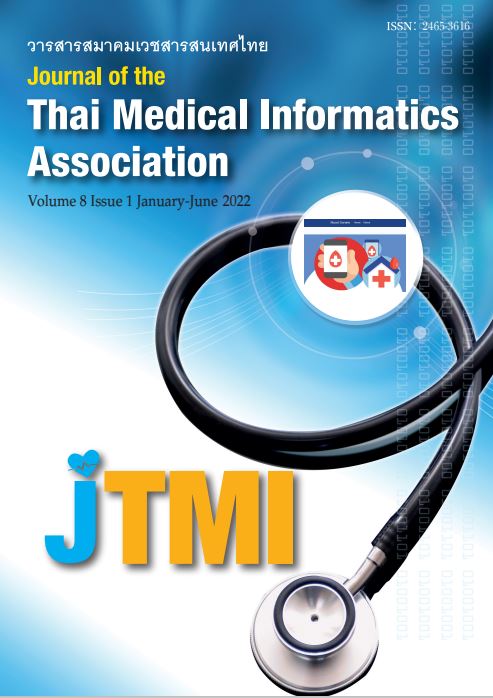Service Quality Development for OPD Thammasat University Hospital
Keywords:
LEAN managemrnt, Service quality development, Work process analysis, SERVQUAL, Thammasat University HospitalAbstract
Thammasat University Hospital has served a large number of patients. Based on statistical data, this number has been continuously increased every year. The number of patients increase while the number of resource is limited. This situation effects on quantity and quality of the provided services. (Thammasat University Hospital, 2019) The hospital realized the challenges and has to continuously improve both medical and supported services. This study aims to improve service quality by utilizing management concepts which are work process analysis, service quality improvement (SERVQUAL) and Lean management to develop hospital’s service system. The research objectives are 1) to study service situation in OPD (office hours) 2) to analyze needs and satisfaction levels of the patients and 3) to develop service quality for the OPD of Thammasat University Hospital by using Lean management. Mix methods research was utilized. The quantitative research was used to collect data from 133 patients to study needs and satisfaction levels. For the qualitative research, interviews were conducted with 9 service providers (executives and supervisors) to understand work processes of the 9 clinics. The results of the study can be concluded that the patients satisfy towards environment dimension of the hospital’s service quality while they highly satisfy towards other 4 dimensions of the service quality, namely, credibility, responsiveness, reliability and empathy. To co-analysis with complaints in the past such as tone of voice of the officers, politeness, long waiting time and lack of clear communication, the study found that these issues have been handled and the current patients are satisfied. By using Lean management to develop service process, the study utilized data from the patients together with from the interviews to draft the service process in the OPD of the hospital, analysed wastes and eliminated them. The service activities were accessed into 3 categories which are value, non-value but necessary, or non-value. The research outcomes offer service process re-design which was reduced from 10 to 6 processes. The 6 processes are 1) scanning barcode to get smart que 2) initial screening 3) medical consulting 4) made a payment 5) receive medicine. Reducing the service process to 6 processes will reduce waiting time, reduce service time, eliminate repeating process and increase value for the rest processes.
References
ศศินภา บุญพิทักษ์ และกรณ์ปภพ รัตนวิจิตร (2561) การศึกษาประยุกต์ใช้แนวคิดลีนเพื่อลดปัญหาการรอคอย กรณีศึกษาแผนกผู้ป่วยนอกโรงพยาบาลพระปกเกล้า จันทบุรี. วารสารมหาวิทยาลัยทักษิณ. ปีที่ 21, ฉบับที่ 2, น. 21-31.
ศิริพร เจริญศรีวิริยะกุล (2554) คุณภาพการให้บริการ โรงพยาบาลทั่วไปของรัฐบาลในเขตจังหวัดปทุมธานี. การค้นคว้าด้วยตนเองหลักสูตรบริหารธุรกิจมหาบัณฑิต. มหาวิทยาลัยเทคโนโลยีราชมงคลธัญบุรี
หนังสือรายงานประจำปี 2562.โรงพยาบาลธรรมศาสตร์ เฉลิมพระเกียรติ. ข้อมูลโรงพยาบาลธรรมศาสตร์.สืบค้น จาก URL: https://www.hospital.tu.ac.th
กิจดี ยงประกิจ (2559) การรับรู้คุณภาพการให้บริการ ของผู้ใช้บริการ บุคลิกการเป็น ผู้ประกอบการ ภูมิความรู้ ความชํานาญ และรูปแบบการคิดของผู้ประกอบการธุรกิจ บูติก โฮเต็ลที่ได้รับรางวัลในประเทศไทย. วิทยานิพนธ์ ปริญญามหาบัณฑิต, มหาวิทยาลัย ธรรมศาสตร์.
วิณารัตน์ ภูวพัฒน์ชัยกิจ (2559) คุณภาพการให้บริการ ของท่าอากาศยานสุวรรณภูมิที่ส่งผลต่อความพึงพอใจของ ผู้ใช้บริการชาวไทย. ค้นคว้าอิสระตามหลักสูตรบริหารธุรกิจ มหาบัณฑิต.มหาวิทยาลัยกรุงเทพ
Zeithaml, P and Berry, L. (1985) A concept model of service quality and its implications for future research. Journal of marketing, 49, (Fall), 41-50.
ปุณยภา พวงทับทิม (2560) คุณภาพการบริการ และ ความพึงพอใจโรงพยาบาล AAA อำเภอศรีราชา จังหวัด ชลบุรี. วิทยานิพนธ์บริหารธุรกิจมหาบัณฑิต. สาขาวิชาการ จัดการธุรกิจโลก, วิทยาลัยพาณิชยศาสตร์, มหาวิทยาลัย บูรพา.
สามารถ ศิริสมพล (2554) การกำหนดจำนวนมาตรฐาน พนักงาน กรณีศึกษา กระบวนการผลิตประกอบ (Assembly Process) ของโรงงานผลิตอุปกรณ์อิเล็กทรอนิกส์แผงวงจร ไฟฟ้าชนิดยืดหยุ่น.วิศวกรรมศาสตร์มหาบัณฑิต. มหาวิทยาลัย ธรรมศาสตร์
พันธิภา พิญญะคุณ (2557) การพัฒนารูปแบบการบริหาร คลินิกเบาหวานโดยประยุกต์ใช้แนวคิดแบบลีน. โรงพยาบาล ศูนย์เจ้าพระยายมราช จังหวัดสุพรรณบุรี.
อนุวัฒน์ ศุภชุติกุล (2552) เอกสารประกอบการประชุม วิชาการประจำปี. การพัฒนาและรับรองคุณภาพโรงพยาบาล ครั้งที่ 10.
อัจฉรา โพธิศาสตร์ (2562) การพัฒนากระบวนการ จำหน่ายผู้ป่วยในกลุ่มงานศัลยกรรม โดยการประยุกต์ใช้ แนวคิดลีน. โรงพยาบาลลำพูน. วารสารสาธารณสุขล้านนา. ปีที่ 15, ฉบับที่ 2, น. 20-33






